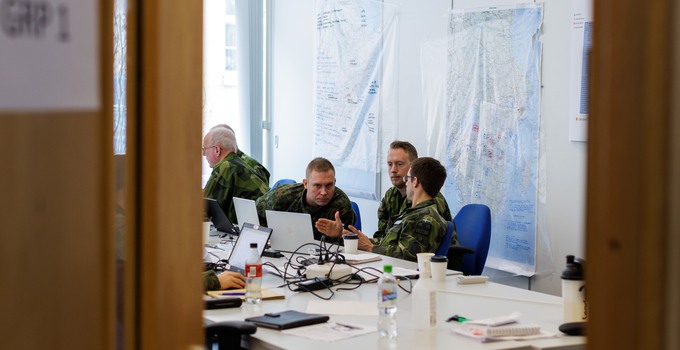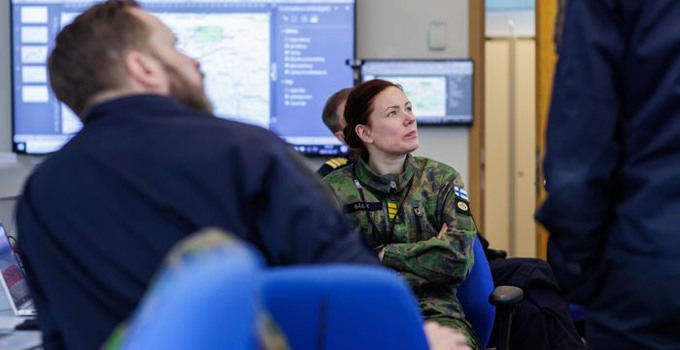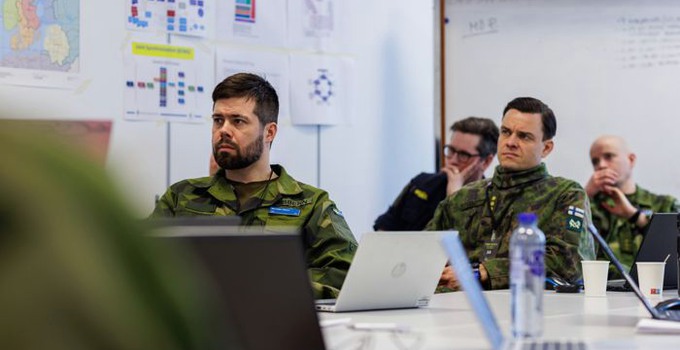
A Joint Swedish-Finnish Exercise Training NATO's Staff Methods and Procedures
Take the opportunity to go behind the scenes of the Training Event Joint Operations (TEJO) 23, a two-week staff exercise, including joint training for our Higher Joint Command and Staff officers and their Finnish counterparts.
TEJO 23 was organised by the Swedish Defence University in cooperation with the Finnish National Defence University.
It is early morning, and snow is gently falling over Stockholm. Inside the Swedish Defence University, the calm wintery feeling is juxtaposed by the sense of anticipation and amount of activity taking place as student officers work intensely preparing the morning briefings. Maps cover the walls with troop movements clearly marked. Officers work feverishly on laptops and low-key discussions can be heard in the background. Critical decisions are being made within twelve fictitious operational headquarters. Each HQ is tasked with reestablishing territorial integrity and protecting the population of a fictitious country under attack within an unstable region.
TEJO 23: Wargaming and table top exercises
During the first week of TEJO 23, some 320 students from The Swedish Defence University’s Higher Joint Command and Staff Programme, and the Finnish National Defence University’s Senior Staff Officer Course and General Staff Course are conducting workshops and lectures in preparation for the second week of wargaming and table top exercises.
Half of the Finnish officers are here in Stockholm, and half of the Swedish students are in Helsinki, and the officers are training simultaneously at both locations. At each site, twelve fictitious operational level headquarters have been established. Each HQ is staffed by twelve people, who have access to approximately twenty uniformed subject matter experts and mentors. The scenarios and discussions are largely the same in all HQs in both Sweden and Finland, as is the atmosphere – a sense of seriousness to their feverish activity.

Northern Continent Scenario
TEJO 23 is based on the fictional "Northern Continent Scenario", and has also taken portions of the Swedish Armed Forces' most recent Viking exercise. In the exercise, Sweden, along with large portions of Finland, comprise the fictive regions Southland, Midland, and Northland. Midland and Northland do not represent countries, but have qualified military capabilities that attacked Southland. Midland is currently engaged in a civil war, and Southland is experiencing internal strife. Norway and Eastern Finland are also included as fictitious states with stakes in the conflict.
The student officers take on the role of a joint NATO headquarters. From their respective operational headquarters, they are to assist the Southland government in restoring territorial integrity and security to the population. This is a military crisis management operation led by NATO and mandated by the UN Security Council. Magnus Bodén is a lieutenant colonel, teacher at the Swedish Defence University, and the coordinator of the exercise. Bodén explains, "The students will deal with a type of conflict reminiscent of Bosnia in the 1990s or Afghanistan, where war is not between sovereign states, but rather NATO against a number of irregular units and non-state actors. Various combat forces and capabilities should be used to achieve the best operational effect – under time pressure – while officers should simultaneously learn NATO's staff methods and procedures”.
Operational dilemmas
The first day of the wargame has just begun with a presentation of the situation and pre-conditions for the day. The level of stress is palpable in the various group rooms and in the clenched faces that pass in the corridors. Student officers have a lot of information to take in and process.
The exercise brings to the forefront a number of operational dilemmas such as resource prioritisation in time and space. Southland is a large geographical area, and resources are limited. The next portion of the exercise involves each branch of service, army, navy, air force, and special forces, presenting their branch’s own capabilities and how these capabilities can be used initially in the conflict within each joint HQ.
Prior to the presentation, intensive discussions will be held in different constellations. One Swedish Army officer draws lines and arrows on a map on the wall together with his Finnish colleague Then, the Swede explains, "Let's drop one brigade here, south of Norrköping. If they are fast, we don't have to fight inside Norrköping. But we go in if they need assistance. It's not important to control Linköping right now, we might need it later."
The staff is divided and assigned to work towards different time lines. One group worked with current tasks while others were assigned midterm, or even with long-term planning tasks to focus on. According to Magnus Bodén, "They should identify operational dilemmas, develop Courses of Action and create a basis for decision-making. The student officers should understand the situation, and collaborate to coordinate a COA that meet the commander’s preferences. If you boil it down, that's what the staff processes are all about," says Magnus Bodén.
Harmonized battle rhythm
It is a complex challenge to create coherence from all the various inputs and procedures, and Magnus Bodén highlights that the actual decision-making at operational and strategic levels is something that usually involves challenges and should therefore be practiced in staff exercises. There are many people and numerous staff roles involved, and they must work in a harmonised manner. Bodén continues, "One strives to work according to a 'battle rhythm' which structures the working days, which meetings are held, when they are held, for what purpose, and how they relate to other meetings. The student officers should also learn how to manage a steady flow of information in a headquarters that normally consists of several hundred people. How does one ensure that everyone has a common situational awareness about what is happening?”

Recurring cooperation with Finland
The Swedish and Finnish Defence Universities have collaborated on this type of exercise for nearly 20 years, and Magnus Bodén describes it as second nature, "Finland has been designated as an important partner for many years – not only for the Swedish Defence University, but also for the Armed Forces and Sweden. I would say that Finland is our most important partner, and I feel that our Finnish colleagues feel the same”.
The original plan was for the student officers from both countries to participate in the Swedish Armed Forces' annual staff exercise, Combined Joint Staff Exercise (CJSE), on site in Enköping. However, this year the Swedish Armed Forces are focusing on the Swedish Armed Forces’ exercise, Aurora, which is the largest joint exercise conducted in many years. To compensate, the universities agreed to adapt a version of the CJSE exercise used during Covid in 2021. They have simply moved the concept and the students back onto the premises and face-to-face.
New contacts for cooperation within NATO
Wargaming is paramount, however an important aspect which should not be underestimated is the social aspect – to network and learn more about how the Swedish and Finnish cultures are similar and different at the same time. Magnus Bodén has added a cultural day to the schedule in addition to a large closing dinner. Boden explains, "The more you get to know each other, the easier it becomes to understand each other”.
Networking now is beneficial now and for the future. After completing their education, many of the Swedish and Finnish students will meet again as they staff the Armed Forces’ Headquarters, the Army HQs, the Naval HQs, and the Air Force HQsl in each country. Furthermore, within NATO, the Swedish-Finnish cooperation will develop further, and this becomes even easier when officers have previously established contacts and networks.
Hopes: Soft values and increased NATO knowledge
When asked what Magnus Bodén hopes the students will take away from the two-week exercise, the answer is increased knowledge and understanding of joint operations, why staff procedures exist, and how the various procedures are connected. Bodén continues, "[Student officers] also gain increased knowledge of NATO and NATO doctrines. Coming back to the soft values: we improve the collaboration with our Finnish colleagues and enhance our preparedness for NATO. This is what I hope for.”
Magnus Bodén adds that he envisions another possible future application to the current exercise, namely to let the Higher Joint Command and Staff Programme and Finnish students conduct the exercise in preparation for their practical joint staff exercises. Bodén explains, "This is a very good way to quickly establish effective working groups and teams, and would be an opportunity to get even more out of a staff exercise.”
More about
Page information
- Published:
- 2023-04-18
- Last updated:
- 2024-05-06
